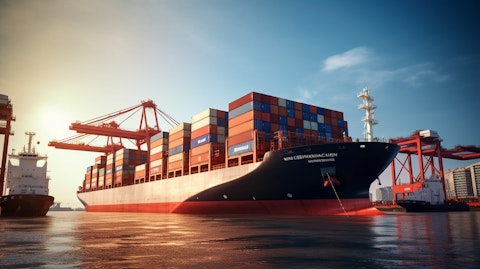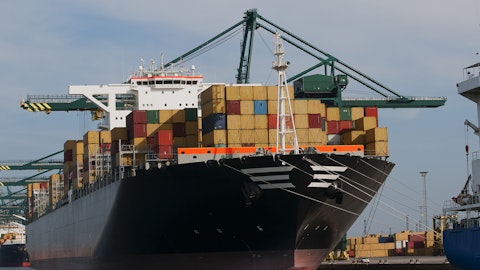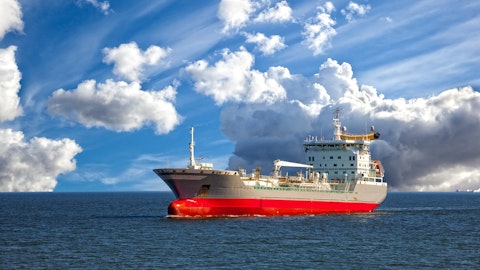Global Ship Lease, Inc. (NYSE:GSL) Q3 2023 Earnings Call Transcript November 9, 2023
Global Ship Lease, Inc. beats earnings expectations. Reported EPS is $2.33, expectations were $2.16.
Operator: Hello and welcome to the Global Ship Lease Q3 2023 Earnings Conference Call. All lines have been placed on mute to prevent any background noise. After the speakers’ remarks, there will be a question-and-answer session. [Operator Instructions] I will now turn the conference over to Mr. Ian Webber, Global Ship Lease CEO. Please go ahead.
Ian Webber: Thank you very much. Good morning everybody. Welcome to Global Ship Lease’s third quarter 2023 earnings conference call. You can find the slides that accompany today’s call and presentation on our website at www.globalshiplease.com. As usual Slides 2 and 3 of our presentation remind you that today’s call may include forward-looking statements that are based on current expectations and assumptions and are by their nature inherently uncertain and outside of the company’s control. Actual results may differ materially from these forward-looking statements due to many factors including those described in the Safe Harbor section of the slide presentation. We would also like to direct your attention to the Risk Factors section of our most recent annual report on our 2022 Form 20-F, which was filed earlier this year on March 23rd.
You can find that form on our website or on the SEC’s. All of our statements are qualified by these and other disclosures in our reports filed with the SEC. We do not undertake any duty to update forward-looking statements. For reconciliations of the non-GAAP financial measures to which we will refer during this call to the most directly comparable measures calculated and presented in accordance with GAAP, please refer to the earnings release that we issued this morning which is also available on our website. As usual I’m joined today by our Executive Chairman George Youroukos, our Chief Financial Officer of Tassos Psaropoulos; and our Chief Commercial Officer, Tom Lister. George will begin the call with a high-level commentary on GSL and our industry.
And then Tassos, Tom, and I will take you through our recent activity, the quarterly results, and financials, and the current market environment. After that we will be pleased to answer your questions. So, turning now please to Slide 4. I’ll pass the call over to George.
George Youroukos: Thank you, Ian and good morning afternoon or evening to all of you joining us today. In the third quarter, charter market activity continued to be muted as macro and geopolitical factors created significant uncertainty and the global fleet remained largely fixed on previously agreed charters. Now, against this backdrop we have successfully re-chartered our ships as they have come open. Although market rates are softening and the charter durations available have shortened considerably, especially for smaller ships. That said, we continue to benefit from our robust contract cover and forward visibility on cash flows. Our balance sheet remains strong with no debt refinancing requirements until 2026 and all our floating interest debt is hedged with an interest rate cap through 2026.
We remain tightly focused on capital allocation and continue to pay an attractive and sustainable quarterly dividend that is well supported by our contracted cash flows. We have also continued to utilize our buyback authorization to repurchase our shares in the market on an opportunistic basis. We have demonstrated our ability to act on attractive acquisition opportunities when they meet our strict criteria. Just as importantly, we have also demonstrated that we will be patient selective and tightly focused on long-term value creation in doing so. We expect that increasingly attractive acquisition opportunities may arise as the cycle plays out and we intend to be ready to move quickly when the time comes, maintaining our resilience in the interim.
With that, I’ll turn the call back to Ian.
Ian Webber: Thank you, George. Please turn to slide five. Here we show the composition of extensive diversification of our charter base, which is spread across top-tier liner companies. As of September 30, 2023, we had approximately $1.8 billion in contracted revenue, with an average remaining duration of 2.1 years. In the first nine months of the year, we’ve signed 18 new charters or charter extensions adding $225 million of contracted revenues. Slide six provides an illustrative view of our future earnings potential under different rate scenarios. As in previous quarterly calls, it’s important to emphasize that this is not a forecast. The charts to illustrate the extent of our contracted revenue and our limited exposure through the end of next year 2024 to charter renewals and thus to the prevailing market at that time with 82% of our 2024 ship days already contracted.
The current year is effectively fully covered. Moving forward, we will continue to see the incremental contribution from a number of the forward charters that we signed some time ago on strong terms, typically extended for multiple years. Our strong forward charter cover provides us with considerable earnings and cash flow visibility, a significant advantage in today’s uncertain macroeconomic environment. Moving on to slide seven. We review the thinking underpinning our disciplined and dynamic capital allocation strategy, which has remained consistent over time and which we revisit regularly. We maintain our sustainable quarterly dividend, which totals $1.50 per share on an annualized basis and we continue to execute opportunistic share buybacks.
We’ve repurchased approximately $22 million worth of shares year-to-date in 2023, including $5 million since June 30, bringing the total to $52 million since we began the program in late 2021. We have approximately $38 million of capacity remaining under the current Board of Directors authorization. We see significant value in deleveraging our balance sheet consistent with the scheduled fixed amortization inherent in our debt agreements and we’ve made great strides in reducing this debt, which should position us well to weather the challenges and to be able to capitalize on the opportunities of an uncertain macro environment and market. With evolving regulations and the demands of decarbonization, we’ve seen good opportunities to invest in our fleet to improve performance, reduce emissions and add commercial value to our ships.
We also believe that it is important to maintain a degree of cash liquidity for both resilience and optionality, particularly as countercyclical acquisition opportunities are increasingly likely to arise. Overall, we intend to remain patient, nimble and focused on long-term shareholder value. Slide 8 demonstrates our consistent and disciplined approach to acquisitions. During the period of sharply elevated asset values, we didn’t make any ship purchases for nearly 2-years instead focused on securing the lucrative charters for our existing fleet de-risking our balance sheet through debt amortization putting in the interest rate caps and buying back shares. Only in May of this year, once asset values had normalized substantially did we’ve purchased 4 vessels with attractive charters attached and a compelling risk return mix.

Selective growth is a vital element of our business model as is clear from our activity level leading up to 2021. But fundamentally, we’re in the business of generating strong risk-adjusted returns, so we will continue to be highly disciplined in deploying capital for growth. Now, I’ll pass the call over to Tassos to discuss our financials.
Tassos Psaropoulos: Thank you, Ian. On slide 9 is a snapshot of our financials. As you can see our major P&L line items such as revenue, adjusted EBITDA, net income and normalized net income continued to improve for the first nine months of this year versus the same period of last year. On our balance sheet we have reduced our gross debt to $874.3 million from $999.5 million at September 30, 2022 despite adding $76 million new debt for the newly acquired vessels. We closed the quarter with $267.3 million in cash $155.3 million of which is restricted, primarily consisting of advance received of charter hire with the remaining $112.1 million covering minimum liquidity covenants and working capital needs. We have also continued to return capital to shareholders, while also building equity value by delivery.
Slide 10 now provides insight into our de-levering efforts and cost of debt reduction over time. We maintain an aggressive amortization schedule that effectively de-risk our balance sheet. That has contributed to our ability to achieve a low cost of debt at 450 basis points, including our 64 basis points interest rate cap on software which we put in place almost two years ago and which runs through 2026. The right side of the slide provides important long-term context as we have reduced our financial leverage from 8.4% at year-end 2018 to 4.2% at the end of 2021 to now 1.7% at September 30 of this year. Our financial leverage has been completely transformed and provides a robust foundation of our business at the time when the cycle is turned.
Tom will now discuss our market focus and SIP deployment.
Tom Lister: Thank you, Tassos. Moving to slide 11. We reiterate our clear focus on high-specification midsized and smaller container ships ranging from 2,000 to about 10,000 TEU. As in previous quarters, the top map illustrates the deployment of ships within our preferred size range, highlighting their operational flexibility, which is a good structural hedge in uncertain times such as these and widespread reach. In contrast, the lower map shows the deployment of larger ships at 10,000-plus TEU and higher which tend to be more constrained to the main east-west arterial routes with sophisticated deepwater port infrastructure. Slide 12 prevents a view of idle capacity and ship recycling. Idle capacity bottomed out at just under 0.9% during the third quarter driven by the extensive long-term chartering that took place in recent years.
From that effectively full utilization, we saw a slight increase in idle capacity to 1.1% at the quarter’s end and this upward trend has continued into the fourth quarter. Logically the, uptick in idle vessels has been accompanied by the return of scrapping activity for essentially the first time since 2020 albeit at a limited scale thus far. The record-breaking charter markets of 2021 and 2022 saw the lives of many older and lower specification container ships extended and thus scrapping deferred due to their phenomenal earnings. However, as the market normalizes there is an expectation that there will be a catch-up in scrapping, regulatory dry dockings, which ships are obliged to go through typically on a five-year cycle prompt owners to consider whether investing a couple of million dollars is justified by forward earnings potential.
When a vessel is aging or poorly specified or both, the answer may well be, no, particularly when there is a challenging market outlook and the ship likely gets scrapped. We’ll come back to what this may mean in a moment. On slide 13, we show the order book, which is heavily weighted towards the larger ship sizes. In other words the over 10,000 TEU segments in which to be very clear GSL does not participate. With an order book-to-fleet ratio of 14.5%, the order book for midsized and smaller container ships, which are the segments relevant to GSL is much smaller but still meaningful. Here the older age profile of the midsized and smaller fleet is important context and ties in with what I was saying earlier about deferred scrapping and the scrap versus invest decisions that may be driven by regulatory dye dockings.
Extrapolating this point, if we were to assume the scrapping of all ships over 25 years old and net those numbers out against the order book for midsized and smaller ships delivering through 2027, our focus segments would see net growth of only 1.2% through 2027, probably an extreme scenario admittedly but illustrative of the supply-side safety valve for the industry in the event of a protracted downturn. Slide 14 looks at the charter market, which together with asset values has been normalizing after the extreme highs of 2021 and 2022 as usual we provide some indicative rates on the right-hand side of this slide. These reflect our best assessment of where things stood at the end of Q3, but there has been further softening into Q4. So take them with a pinch sold.
Frankly a combination of an uncertain macroeconomic and geopolitical outlook combined with the usual seasonal weakness in the market, makes it unsurprising that rates are under some pressure. Now I’ll turn the call back to George to conclude our prepared remarks on slides 15 and 16.
George Youroukos: Thank you Tom. On slides 15 and 16, we provide a summary of key points. We have continued to grow our EBITDA on the back of attractive forward contracts signed during the market upswing. We have no reliance on additional charter renewals to cover our debt service CapEx and dividends through 2024. We have remained squarely focused on the midsized and smaller containership space and we have made excellent progress in positioning GSL to be financially strong and strategically flexible throughout the cycle, benefiting from the well-timed hedging of floating rate debt and continued delevering. Macro certainty continues to exert downward pressure on market sentiment and the liners are providing cautious guidance, though they do so with significantly fortified balances.
Now having said all that, container shipping has always been cyclical and cyclicality presents opportunities. Our business model is designed to build, but also very importantly to preserve value for shareholders through both the highs and the lows of the cycle. So capital allocation is disciplined, but nimble allowing us to derisk the business, pay a sustainable dividend to shareholders and opportunistically buy back shares. And also, when the cycle turns Aeris doing now to capitalize selectively on the right value building purchase opportunities that may arise. Now, we’re ready to take your questions.
See also 10 Biggest Dividend Cuts of 2022 and 15 Countries That Produce the Most Gold.
Q&A Session
Follow Global Ship Lease Inc. (NYSE:GSL)
Follow Global Ship Lease Inc. (NYSE:GSL)
Operator: [Operator Instructions] Your first question comes from the line of Omar Nokta with Jefferies. Your line is open.
Omar Nokta: Thank you. Hi, gentlemen, good afternoon. Thanks as always for the update always providing good detail on both the company’s strategy and just sort of the market in general. I did want to come back George just in your latest comments talking about aligners and some of the cautious discussion that they’ve had here recently and sort of think about opportunities on that front. There’s a big focus or an increasing focus on the part of liners to cut costs or catering in cost where they can. We know there’s a big order book and a lot of those orders have been placed outright by those liners themselves and it seems perhaps that maybe there could be a chance for them to look to refinance those as — or maybe recapitalize them that they come closer to delivery, freeing up capital on their end and chartering them back, do you see that as something on coming for the industry?
And is there any evidence of that happening at the moment? And is GSO, do you guys have the interest to participate in something along those lines?
George Youroukos: Thank you. Well, I’d say that I don’t believe that liner companies — I mean it might happen but it’s unlikely that will happen in a large extent to sell out their new builds with a charter back. I think it’s more likely that liner companies will do what they’ve been doing always all these years, is liner companies cannot operate very efficiently older ships middle age ships and older. They have higher costs for them. So we have seen that when things — when lancers are trying to cut costs, they will be selling existing ships, older ships millets and older two ship owners like us like GSL. And taking them back on charter as in this way they cut cost because an older ship for them is something that they can’t operate as efficiently as we do, because their focus is a different business ballgame.
So I think that we will see more and more of these deals, as we have been seeing in the past rather than them selling their strategic assets the new build the big ships with the charter because regardless, if they give a charter even 10 years, still the ship has another 15 years of life so they’re losing the optionality of the asset.
Tom Lister: This is Tom. Just to add to that during the super hot years of 2021 and 2022, we saw the liner companies because they were so eager to secure capacity by a lot of secondhand tonnage out of the “charter market”. And I think to all of the points that George has already made, not all of those liner companies are necessarily natural holders of older tonnage. So, that may be a further spur send those ships potentially back into the charter market by way of sale and charter back. So, yes, we do see that as a potential area of opportunity. Let’s see how it develops.
Omar Nokta: Interesting. That’s actually very, very interesting color on both fronts. Thanks George and Tom on that. And maybe just a follow-up and to you Tom perhaps you did talk about this in your remarks in the presentation. about older ships in the global fleet. Obviously, GSL you guys have invested I would say very wisely. And always it seems in a derisked fashion. You do have a handful of ships over the coming maybe a couple of years that are in that 20-year range that starts to roll off charter. I know it’s still maybe a bit a ways away but how are you thinking about what to do with those vessels as they roll off? Have you already sort of earmarked them for scrap? Do you prefer to hold them for optionality perhaps even if employment isn’t so readily available as soon as they come open? Any kind of color you’re able to share on what you kind of think or plan to do with some of the older vessels in your fleet?


